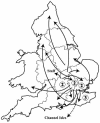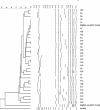Emergence, spread, and characterization of phage variants of epidemic methicillin-resistant Staphylococcus aureus 16 in England and Wales
- PMID: 15528709
- PMCID: PMC525207
- DOI: 10.1128/JCM.42.11.5154-5160.2004
Emergence, spread, and characterization of phage variants of epidemic methicillin-resistant Staphylococcus aureus 16 in England and Wales
Abstract
Epidemic methicillin-resistant Staphylococcus aureus 16 (EMRSA-16) and EMRSA-15 are the two most important and prevalent EMRSA strains found in the United Kingdom and have also been found in a number of European countries and the United States. We describe for the first time the spread of an EMRSA strain (EMRSA-16) from its point of origin in one hospital to the surrounding hospitals and regions over the following 2 years. In the first 18 months after its original appearance, 136 hospitals referred EMRSA-16 isolates for typing, and interhospital and intraregional spread were reported: it was more prevalent in males between 60 and 80 years old and was isolated from sputum and throat more often than EMRSA-15. Important characteristics, e.g., carriage of the enterotoxin A (sea) and toxic shock syndrome toxin (tst) genes and production of urease, are described. Phage-variant strains of EMRSA-16 which share some of the characteristics of the classical strain, including toxin carriage and urease production, emerged, but without genotypic investigations, their relationship could only be inferred. A total of 129 clinical isolates from 52 hospitals, collected between March 1998 and April 1999 and representing classical EMRSA-16 (49 isolates) or phage variants (80 isolates), were compared by phage typing, pulsed-field gel electrophoresis (PFGE) following SmaI macrorestriction, antimicrobial susceptibility testing, urease production, and PCR detection of toxin gene carriage. PFGE analysis revealed 29 profiles, A1 to A29, with A1 representing the prototypic strain, NCTC 13143. All other profiles differed from A1 by 1 to 6 bands, but some differed from each other by up to 10 bands.
Figures


Similar articles
-
Identification and characterization of phage variants of a strain of epidemic methicillin-resistant Staphylococcus aureus (EMRSA-15).J Clin Microbiol. 2001 Apr;39(4):1540-8. doi: 10.1128/JCM.39.4.1540-1548.2001. J Clin Microbiol. 2001. PMID: 11283084 Free PMC article.
-
Characterisation of non-multiresistant methicillin-resistant Staphylococcus aureus (including EMRSA-15) in Kuwait Hospitals.Clin Microbiol Infect. 2006 Mar;12(3):262-9. doi: 10.1111/j.1469-0691.2005.01350.x. Clin Microbiol Infect. 2006. PMID: 16451414
-
Irish-1 and Irish-2: UK epidemic meticillin-resistant Staphylococcus aureus strains associated with Northern Ireland.J Hosp Infect. 2006 Jun;63(2):170-8. doi: 10.1016/j.jhin.2005.12.012. Epub 2006 Apr 24. J Hosp Infect. 2006. PMID: 16632075
-
Characterization of isolates of methicillin-resistant Staphylococcus aureus from Hong Kong by phage typing, pulsed-field gel electrophoresis, and fluorescent amplified-fragment length polymorphism analysis.J Clin Microbiol. 2003 Nov;41(11):4980-5. doi: 10.1128/JCM.41.11.4980-4985.2003. J Clin Microbiol. 2003. PMID: 14605127 Free PMC article.
-
A new UK strain of epidemic methicillin-resistant Staphylococcus aureus (EMRSA-17) resistant to multiple antibiotics.J Antimicrob Chemother. 2002 Aug;50(2):171-5. doi: 10.1093/jac/dkf117. J Antimicrob Chemother. 2002. PMID: 12161396
Cited by
-
Prevalence and WGS-based characteristics of MRSA isolates in hospitals in Shanghai, China.Front Microbiol. 2022 Nov 3;13:1002691. doi: 10.3389/fmicb.2022.1002691. eCollection 2022. Front Microbiol. 2022. PMID: 36406454 Free PMC article.
-
Isolation and characterization of an epidemic methicillin-resistant Staphylococcus aureus 15 variant in the central United States.J Clin Microbiol. 2008 Oct;46(10):3548-9. doi: 10.1128/JCM.00985-08. Epub 2008 Jul 30. J Clin Microbiol. 2008. PMID: 18667592 Free PMC article. No abstract available.
-
A field guide to pandemic, epidemic and sporadic clones of methicillin-resistant Staphylococcus aureus.PLoS One. 2011 Apr 6;6(4):e17936. doi: 10.1371/journal.pone.0017936. PLoS One. 2011. PMID: 21494333 Free PMC article.
-
Evolution of community- and healthcare-associated methicillin-resistant Staphylococcus aureus.Infect Genet Evol. 2014 Jan;21:563-74. doi: 10.1016/j.meegid.2013.04.030. Epub 2013 May 3. Infect Genet Evol. 2014. PMID: 23648426 Free PMC article. Review.
-
Impact of universal screening on MRSA bacteremias in a single acute NHS organisation (2006-12): interrupted time-series analysis.Antimicrob Resist Infect Control. 2013 Jan 14;2(1):2. doi: 10.1186/2047-2994-2-2. Antimicrob Resist Infect Control. 2013. PMID: 23316746 Free PMC article.
References
-
- Anonymous. 1993. EMRSA-16; a new epidemic strain of Staphylococcus aureus. Commun. Dis. Rep. 3:5 February. - PubMed
-
- Anonymous. 1993. The spread of EMRSA-16. Commun. Dis. Rep. 3:2 July. - PubMed
-
- Anonymous. 2000. North-South study of MRSA in Ireland in 1999. Brunswick Press Limited, Dublin, Ireland.
-
- Anonymous. 2001. Methicillin-resistant Staphylococcus aureus (MRSA) reports to SCIEH. Scott. Ctr. Infect. Environ. Health Wkly. Rep. 35:147.
-
- Arbeit, R. D. 1997. Laboratory procedures for epidemiologic analysis, p. 253-286. In K. B. Crossley and G. L. Archer (ed.), The staphylococci in human disease. Churchill Livingstone, New York, N.Y.
Publication types
MeSH terms
Substances
LinkOut - more resources
Full Text Sources
Medical
Miscellaneous

